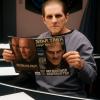|
STAR TREK DEEP SPACE NINE PHOTO GALLERY #01 |
Updated: November 19, 2025





























































.jpg)





































Before Deep Space Nine aired back in 1993 I felt quite a bit of apprehension. How could they have a Star Trek series without a ship going off exploring? I wasn't going to watch it but being a fan Star Trek and Star Trek: The Next Generation I had to watch it.
I was pleasantly surprised by Deep Space Nine. The stories were fantastic. The writers were very imaginative they had to be. There was no jetting off in starships from planet to planet. Everything was set on Deep Space Nine which made for more interesting storylines. And storylines continued throughout the season. Deep Space Nine was not like most sci-fi shows where starships leave a planet at the end of the episode and jet off to their next adventure. Instead, all the action came to Deep Space Nine instead.
The characters were good too and not all of them were buddies with each other. Avery Brooks made a good Commander and the talented Nana Visitor did a good job playing Kira. Two other memorable characters were the mysterious Odo and the slimy Quark.
If anyone wants to watch a thought provoking show without seeing starships jetting off from galaxy to galaxy then this is the show for you.
|
 HOME
HOME
 About
About
 EMail Me
EMail Me TOP |
TOP |  PREVIOUS ITEM | NEXT ITEM
PREVIOUS ITEM | NEXT ITEM  ( 14 of 67 )
( 14 of 67 )





























































.jpg)





































